Barbara Bain Interview
TV Zone 38 (January 1993) p32-37
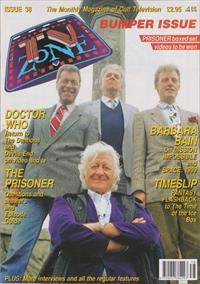
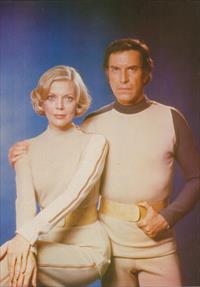
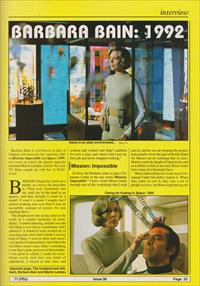
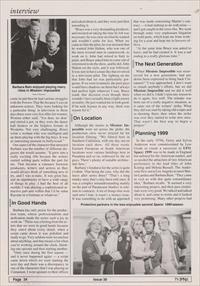
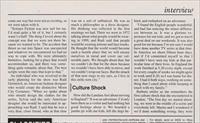
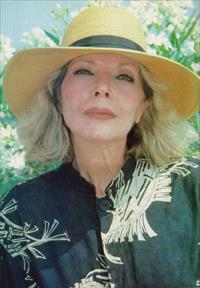

Barbara Bain is well-known to fans of fantasy television for her starring roles in Mission: Impossible and Space: 1999; two series in which she played opposite husband Martin Landau. Earlier this year TV Zone caught up with her in Hollywood.
Barbara began her career as a model, in a move she describes as "Plain luck. Somebody saw me, took me by the hand to an agency, and they thought I could be a model. It wasn't a career I sought, but I started working and even then it was an incredible amount of money for just standing there."
The progression into acting came as the result of a similar incidence of serendipity. "I started dancing, and that was the first thing I ever did as a performer and I adored it. A friend of mine invited me to an acting class, but I didn't think it was my kind of thing. I went in there and wasn't very good at it immediately, but I liked the fact that it wasn't easy; there's something in me that's quite perverse in that manner. I was good at school, I could do everything easily and this was kind of ephemeral. I stayed at that class and worked and worked and didn't audition for over a year, and when I did I got my first job and never stopped working."
So how did Barbara come to play Cinnamon Carter in the spy series Mission: Impossible? "I knew writer Bruce Geller through one of the workshops that I took part in, and he was developing the project and actually wrote the part of Rollin Hand for Martin out of watching him in class. Martin could do sleight of hand tricks and as a tribute to him as an actor Bruce made him a man of a thousand faces.
"Bruce later told me he wrote me as Cinnamon Carter but didn't realize it. When they came to cast it, they saw a lot of people in town, but Bruce kept having me Photo O Paramount come in and then he had various struggles with the Powers That Be because I was an unknown actress. They were looking for a particular thing: in television in those days there were very few roles for women. Women either said, 'Yes dear, no dear' and stirred a pot, Or they were the dance hall hostess or the helpless female in Westerns. Not very challenging. Bruce wrote a woman who was intelligent and up there playing with the big boys. It was an interesting moment in Hollywood."
One aspect of the character that attracted Barbara was the number of different disguises she would assume. "It grew into a really exciting role because the writers started writing parts within the part for me. That became a romance between producers, writers and actress as they would always think of something new to try, and J was ecstatic. It was great fun, and an opportunity to have a wide range of things to play. I had the best of all worlds; I was playing a sophisticated attractive part and within that I'd be some Russian or a German or whatever.
Barbara has only praise for the production team, whose professionalism and dedication made the series such a joy to work on. "There was a feeling from the actors that we were in good hands because they cared about every detail; when a script came down it was polished and ready to go. Very seldom were we unclear about anything, and that means a lot when you're working around the clock, finishing one episode and then starting another.
"Only once during the first season and it never happened again - a script came down which we were starting the next day and there was a discrepancy in one of the characters that I was playing as Cinnamon. I went upstairs to their offices and asked about it, and they were just then amending it.
"Bruce was a very demanding producer, and insisted on taking the time he felt was necessary; he was clear on what he wanted and wouldn't settle for less. When we came to film the pilot, he was insistent that he wanted John Halton, who was one of the most revered men in camerawork, to work on it. John had retired to Italy to paint, and Bruce asked him to come out of retirement to do the show, and he did. John Halton set the style, and it was followed. It was rare to have a man like that involved in a television pilot. The lighting on me that John had set was particularly gorgeous. If we were in tunnels, the poor guys would have shadows on them but I always had perfect light wherever I was. Bruce made that decision even though there wouldn't have actually been a light source in reality. He just wanted me to look good. If he took licence in any way, there was reason for it."
Although the stories in Mission: Impossible were set across the globe, the production crew never strayed far for location filming. "We filmed here in Southern California, with one day out on location each show. All those exotic Eastern European or South American locations were various buildings here in Pasadena and so on, redressed by the set guys. There's plenty of suitable architecture here. "
Barbara's fondness for the series is quite evident. That being the case, why did she leave after series three? "That's a long murky story that's only been told once. It was a complex misunderstanding mainly on the part of Paramount Studios in relation to contracts. A lot of things that were said aren't true: it wasn't a money issue. It was something to do with an approach that was made concerning Martin's contract - it had nothing to do with mine and I got caught in the cross-fire. We went through some very unpleasant litigation on both parts, which kept me from working for a year and kept me in lawyers offices.
"At the same time Bruce was asked to leave, and he had created it. It was a sad ending to a really glorious time."
When Mission: Impossible was resurrected for a new generation, had any desire been expressed to bring back Cinnamon? "I was approached. I don't want to smash anybody's efforts, but we did Mission: Impossible and we did it well when we did it. I didn't seen any reason to do it again, less well. The remake was born out of a really negative situation, as it came out of the writers' strike. What they did was start by taking old scripts and re-shooting them, then when the strike was over they started to write new ones. That wasn't the best way to begin a project."
In the early 1970s, Gerry and Sylvia Anderson were commissioned by Lew Grade to create a successor to UFO. Space: 1999 was to be made in England but tailored for the American market, and so needed the attraction of two American performers in the lead roles of John Koenig and Helena Russell. The Andersons flew out to Los Angeles to meet Martin Landau and Barbara Bain. "They came to visit us with this quite extraordinary idea," Barbara recalls. "It seemed a very interesting project, and their past credentials were very good. We talked and talked about it, and came to terms and it looked very promising. Many other projects had come our way but were not as exciting, so we were taken with it.
"Science fiction was new turf for me. I'd read quite a bit of it, but I certainly wasn't a buff. The thing I loved about the concept was that we were not there because we wanted to be. The accident that thrust us out into Space was unexpected and whatever we encountered we had no way to cope with. We were ultimately homeless, looking for a place that would accommodate us, and there was something quite romantic about that. The best scripts were the ones that kept to that."
An individual who was involved in the early planning for the show was Rudi Gernreich, an American fashion designer who would create the distinctive Moon City Costumes. "When we spoke about who should design the clothes for the series, Sylvia said the only American designer she would be interested in approaching was Rudi. I said that he was a very dear, close friend, who at that time was on a sort of sabbatical. He was as much a philosopher as a dress designer. His thinking was reflected in the first meetings we had. There we were in 1972 talking about what people would be wearing in 1999, and Rudi said that people would be wearing armour and face masks. He thought that the world would become such a hostile place that we will encase ourselves in metal and cover our vulnerable parts. We thought about that, but we couldn't do that for the show because we wouldn't have been able to move, and we couldn't wrap our faces. But the smack of that now rings in my ears, as I live in this strife-torn city."
How did the Landaus feel about moving to England? "It was an adventure. I'd only been there as a visitor and had nothing but good feelings about it. We boarded a jumbo jet with our kids, left the dogs behind, and embarked on an adventure. "I found the English people wonderful, and had fun noticing the minor differences between us. It was a glorious experience for our kids, and we got to travel a great deal on our weekends. It was also good for me because I'm not sure I would have done another TV series at that time. In America we shoot fifteen hour days, and if I'd committed myself to that I wouldn't have seen my kids at that particular time of their lives. In England the work finished at 5.20 every night, except for every couple of weeks we might agree to work until 8.20, so I was home for dinner. I had it both ways, working on something that I cared about while keeping in touch with my family."
Barbara smiles as she remembers the first culture shock that she encountered in London. "The first day we started shooting, we were in the middle of a scene and everybody left. Martin and I wondered if we'd done something wrong; they were all heading towards the other side of the studio. The tea trolley had arrived, and we hadn't seen anything like that before!
Another new experience with a large amount of and special effects: "We did not see any of the special effects until they were produced and edited into the film. We were looking up at a blank screen, and then they were added in. We never knew we were looking at. I loved finding out that there was no point filming certain scientific truths, like the fact that there would be no sound on the explosions in space. We tried the effects without sounds, but it doesn't work - the audience is expecting a noise.
One of the most bizarre episodes of Space: 1999 was Full Circle, in which the inhabitants of Moonbase Alpha revert to primitives. Having mentioned that she enjoyed Mission: Impossible because the lighting showed her at her best. how did Barbara feel about the unglamorous aspects of this episode? "I adored that. They darkened my teeth and matted up my hair and I ran around in skins. I remember thinking about eleven o'clock in the morning that I was shooting a sequence running out of a cave after lunch, and I thought I should find some very primal guttural sound for this creature. I went to my dressing room overlooking Black Park and tried out some animal sounds. I don't know if people were worried about what was going on in there!"
The series' strong regular cast was complemented by some very well-known guest stars led by some superb directors. Was there anybody that Barbara particularly enjoyed working with? "Margaret Leighton (Arra in Collision Course) was just wonderful and comes immediately to mind. Billie Whitelaw (Zamara in One Moment of Humanity) I had always admired. John Standing (Jack Tanner in Death's Other Dominion) was great [Standing was Pasc in The Mark of Archanon]. There were a lot of good actors available because we were filming in London.
"As for directors, it was absolutely delicious to work with Charles Crichton, who is a self-appointed oldest, meanest grouch in the whole world, but is actually a darling. I was delighted to see him win an Academy Award nomination for A Fish Called Wanda. He dates back to the Ealing days, and it was nice to have a man of his stature on our set."
After completing the first season, the Landaus returned to America for a short break before filming commenced on another batch of twenty-four episodes. There were some changes in the second season however: a new producer, the loss of some regular characters and the addition of two new faces on Moonbase Alpha. Barbara Bain's feelings echo those of many viewers: "I wasn't as happy with the second season. It wasn't as clear for me what the intent was, and the changes were cosmetic as opposed to philosophical. Some of the ideas were good, but some were not."
Looking back over the forty-eight Space: 1999 stories, does she have any favourites? "Certainly the Black Sun, which wasn't a story I had a major role in, but it was just lovely where Barry Morse and Martin turned into old men. I liked War Games, where I was captured and put in a glass case. I have them all on tape, but I don't have access to them at the moment as I'm in the middle of reconstructing a house and they're all boxed up.
"I think the ratio of good to weaker scripts was higher on Mission than Space, but there were still some wonderful ones. There was some difficulty in the script writing. English writers are used to writing a drama that builds and builds and comes to a peak and a denouement. In America you have fifty minutes to tell the story, ten minutes of commercials with a certain number of breaks, and for each break you have to have a cliffhanger to keep the viewers hooked. That wasn't really understood by some writers, who resisted the idea of these false cliffhangers. I think that is more accepted now. It was an ongoing problem, and there were discussions late into the small hours."
Were there ever any plans to produce a third season? "There must have been discussions, but I don't remember them. We were in England for four years. We stayed a little longer than the production lasted, and I was quite reluctant to leave, but it was time to move onto something else."
On her return to America, Barbara did more television work and a great deal of theatre: "I returned in really exciting roles. I hadn't been back to the theatre in a long time." She is now in a position to pick and choose what she wants to do, but still finds time to attend Space: 1999 conventions in America. Barbara Bain hasn't left the series behind her just yet...
David Richardson